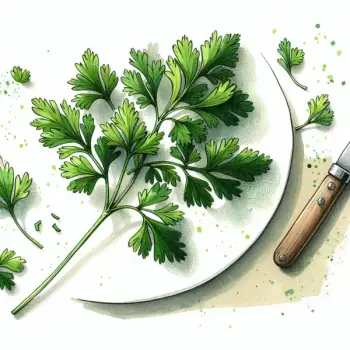Cilantro and parsley are distinct herbs used in cooking for their unique flavors; cilantro offers a bright, lemony taste while parsley provides a more subtle, peppery note. They enhance various dishes from salsas to soups, but are not interchangeable due to their different taste profiles.

Cilantro, also known as coriander, is a fragrant herb commonly used in Latin American, Middle Eastern, and Asian cuisines. Its bright and citrusy flavor profile is distinctive and it is often used fresh in dishes like salsas, curries, and as a garnish.

Parsley is a mild, slightly peppery herb that is widely used in European, Middle Eastern, and American cooking. It comes in two varieties: flat-leaf (Italian) parsley and curly parsley. Parsley is often used as a garnish, in sauces, and to add a fresh note to dishes.
Cilantro has a robust, tangy lemon-lime taste and a tender texture, which some people perceive as soapy due to genetic variances. Parsley, on the other hand, has a more subtle flavor with a slightly bitter edge and a crisp texture.
Cilantro is often used in bold-flavored dishes where it stands as a key flavor, while parsley is used to balance and subtly enhance the flavors of a dish without overwhelming them.
Cilantro is more prevalent in Mexican, Indian, and Southeast Asian cuisines, whereas parsley is more commonly found in Mediterranean, Middle Eastern, and European dishes.

Your ultimate Recipe Box, Meal Planner, and Cooking Class all in one
Best used in Mexican salsas, chimichurri, and Asian dipping sauces, cilantro brings a refreshing and zesty flavor that complements spicy and savory notes. Parsley is ideal for Italian pesto, gremolata, and French béarnaise sauce, lending a subtle herby backdrop that doesn't overshadow other ingredients.
Cilantro is often added towards the end of cooking in dishes like pho, Indian curries, and Latin American stews to maintain its fresh flavor. Parsley can be used both as a cooking herb in the base of soups and stews, such as minestrone or chicken soup, and as a garnish to add a hint of color and taste.
In salads, cilantro pairs well with robust and acidic flavors. It's a staple in Thai beef salad, taco salads, and can be a bold addition to citrusy dressings. Parsley offers a fresh, clean taste in Mediterranean salads, like tabbouleh, and is a classic in herb salads or mixed with lettuces for an additional layer of flavor.
Both cilantro and parsley are low in calories and contain various vitamins and minerals, making them a healthy addition to meals.
| Nutrient | Parsley ( Per Cup ) | Cilantro ( Per Cup ) |
|---|---|---|
| Iron | 3.7 mg | 0.1 mg |
| Calcium | 83 mg | 14 mg |
| Calories | 22 | 4 |
| Vitamin A | 1013 IU | 2704 IU |
| Vitamin C | 80 mg | 2.8 mg |
| Vitamin K | 984 mcg | 12.4 mcg |
Cilantro can be used as a substitute in tabbouleh for a different flavor profile, but it will not provide the traditional taste associated with parsley.
Some individuals have a genetic trait that makes cilantro taste like soap due to the presence of aldehyde chemicals in the herb which are also found in soap.
Both can be used for garnishing, but parsley offers a more neutral taste and is often preferred for its crisp texture and bright color.
Dried cilantro loses a lot of its flavor, so it's best to use fresh. If necessary, dried can be used but the flavor will not be as potent.
Both herbs can be stored in the refrigerator, wrapped in a damp paper towel and placed in a plastic bag. Alternatively, they can be kept in a glass of water like a bouquet with a plastic bag loosely covering the leaves.